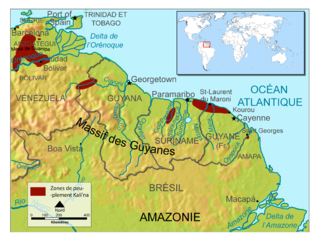|
Carib language
Carib or Kari'nja is a Cariban language spoken by the Kalina people (Caribs) of South America. It is spoken by around 7,400 mostly in Brazil, The Guianas, and Venezuela. The language is currently classified as highly endangered.[2] NamesThe language is known by several names to both its speakers and outsiders. Traditionally it has been known as "Carib" or "Carib proper" in English, after its speakers, called the "Caribs" in English. It is known Caribe in Spanish, Galina in French, and Karaïeb in Dutch. However, the speakers call themselves Kalina or Karìna (variously spelled), and call their language Karìna auran [kaɽiɁnʲauɽaŋ].[3] Other variants include Kali'na, Kari'nja, Cariña, Kariña, Kalihna, Kalinya; other native names include Maraworno and Marworno. ClassificationKari'nja is classified as a Cariban language, in the Guianan Carib branch.[4] Geographic distribution
Due to contact with Kari'nja invaders, some languages have Kari'nja words incorporated into them, despite being Arawakan languages linguistically.[5] A Carib-based lengua generale was once used in the old missions of the Oyapock and surrounding regions, apparently surviving at least along the Uaçá tributary into the 20th century.[6] In Suriname, there is a village called Konomerume which is located near the Wajambo River. With about 349 people living there, a majority identify as ethnically Kari'nja and as for who knows the language, the adults are reported to at least have a decent knowledge of it. Those above the age of 65 use the language as a primary language among the members of the community. Speakers between the ages of 45 and 65 tend to use the language only when speaking with older residents or elder members of their family, while for the most part using the official languages: Dutch and Sranan Tongo. Younger adults between the ages of 20 and 40 for the most part understand the language but do not speak it, and children learn bits about Kari'nja in school.[7] DialectsCarib dialects (with number of speakers indicated in parentheses):[3]
PhonologyIn the Kari'nja language, there are four syllable patterns: V, CV, VC, CVC; C standing for consonants while V means a vowel. Regarding phonemes, consonants are divided into two groups: obstruents (voiceless stops—p, t, k) and resonants (voiced stops—b, d, g, s).[8] Kari'nja has a typical 6 vowel system after *ô merged with *o, being a e i o u ï. Compared to past Kari'nja, the modern day Kari'nja has replaced the e in many words to o.[5]
Allophones for /r w t/ include sounds as [ɽ β,v tʃ]. /s/ before /i/ may be pronounced as [ʃ]. /n/ before a consonant may be pronounced as [ŋ] and also [ɲ] elsewhere. Another sound, ranging [h~x], often occurs before a voiced or voiceless consonant, and succeeding a vowel, it can also be an allophone of /ʔ/.[8][3] AlphabetThe Carib alphabet consists of 15 letters: a, e, i, j, k, `, m, n, o, p, r, s, t, u, w, y.[3] GrammarThere are 17 particles within Kari'nja which include the ky- prefix and the -ng suffix.[9]
VocabularyAll four dialects of Kari'nja have loan words from the primary language of the area (Brazil, Suriname, Guyana, French Guiana). For example, the Kari'nja spoken in Suriname borrows words from Dutch and Sranantongo.[2] Examples
Some of the words show instances in which the e has been replaced with o in present-day Kari'nja.[5] The two statements beneath the singular words show examples of two suffixes.[10] References
External links
|
|||||||||||||||||||||||||||||||||||||||||||||||||||||||||||||||||||||||||||||||||||||||||||||||||||||||||||||||||||||||||||||||||||||||||||||

